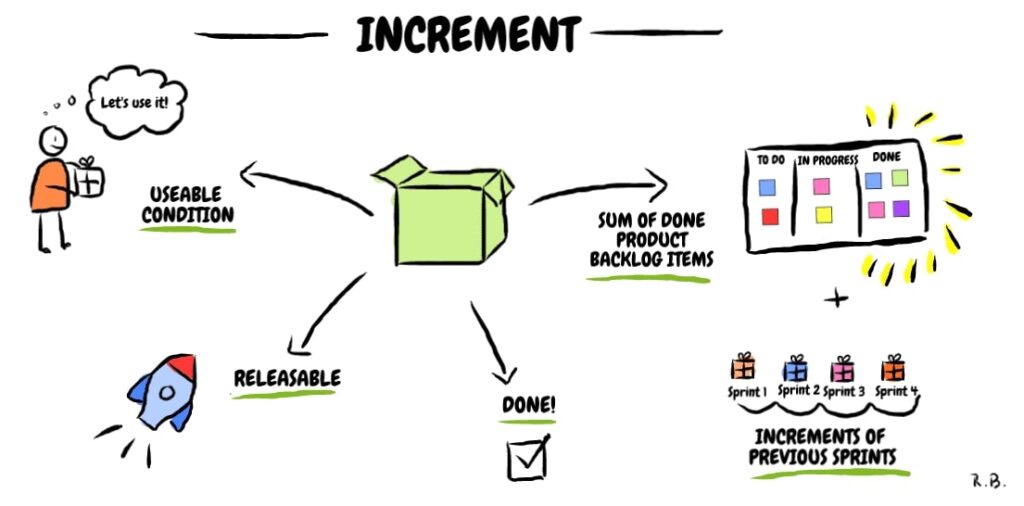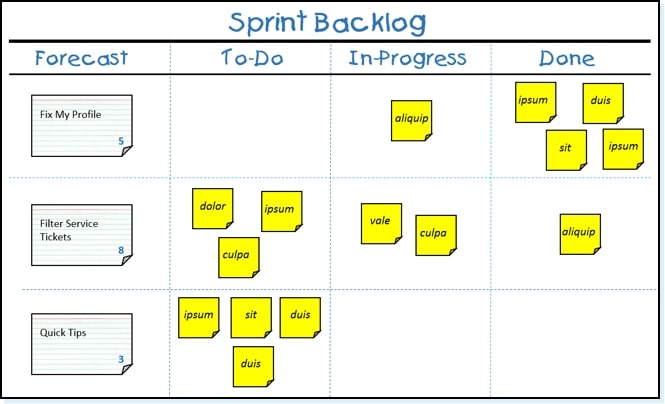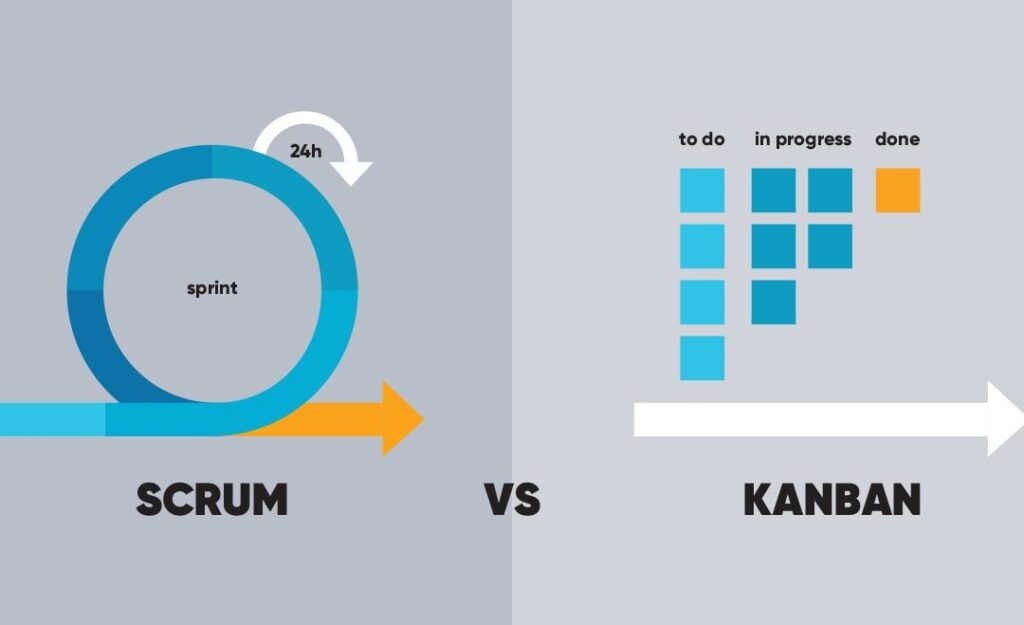Many organizations today reap the benefits of using scrum for their product development.
This article explains what Scrum is, how it differs from Agile and Kanban, and the importance of Scrum in Agile teams.
What is Scrum?
Scrum is a simple project management framework for addressing complex problems through adaptive solutions. This lightweight frame is just applicable to the software industry, but it also applies to any industry that delivers frequent innovative products to customers. According to Scrum.org, Scrum takes an iterative and incremental approach to product development where the “Scrum Master” facilitates an environment that:
- A Product Owner orders the work for a complex problem into a Product Backlog.
- The Scrum Team turns a selection of the work into an Increment of value during a Sprint.
- The Scrum Team and its stakeholders inspect the results and adjust for the next Sprint.
- Repeat

Credits: Digite
The scrum combines the values of three pillars; transparency, inspection, and adaptation. It means that the work of scrum must be transparent to others. The teams must inspect the work progress in a frequent manner, and if the process you are following deviates from your product delivery goals, teams must execute adjustments to the process as early as possible.
To learn more via video, watch below. Otherwise, skip ahead.
Now, let’s get to know some key attributes and components of the Scrum framework.
Scrum Values
The Scrum endorses four values :
- Commitment
- Focus
- Openness
- Respect
- Courage
The Scrum teams value the commitment toward achieving the end goal while supporting others during the Scrum execution. Their key focus is completing the work they have committed to, and they are open about any challenges they face to resolve them. They respect other people’s opinions and have the courage to always follow the right path.
Scrum Team
The fundamental component of Scrum is a cross-functional team that consists of people with different job roles. Within agile development, a Scrum team consists of the Product Owner, Scrum Master, Development team, QE engineers, and Managers. A Scrum team is a self-organizing unit that values everyone’s opinions on key decisions rather than one leader taking all the decisions. It values everyones’ contribution to the decisions.
Scrum Artifacts
Scrum framework maintains the following artifacts visible to everyone to track the work progress.
- Product Backlog: The list of product-related work created in user stories and tasks. Each user story contains the acceptance criteria.
- Sprint Backlog: The list of product backlog items chosen for each sprint. The scrum teams formulate the sprint backlog in each print based on the feedback from the product and their decision on what they commit in each sprint.
- Increment: Represents the total accomplished goals during a sprint.

Credits: Let’s Scrum It
The above Scrum artifacts relate to commitments that help deliver a high-quality product.
- Definition of Done – Describes what teams must do to satisfy each increment. The team has a clear picture of what work they need to accomplish to mark the sprint as done by product managers.
- Sprint Goal – The goal of the sprint backlog reflects the work teams must do as well as why they must do them. For example, the team needs to accomplish a certain item that is a prerequisite to another task. The sprint goal measures progress by using the total number of story points committed to the sprint. Use charts such as the Sprint Burn-down chart and the Sprint burn-up chart to track the progress of the sprint goal.
- Product Goal – The overall objective of the product for each sprint. This reflects the product owners’ prioritized items for each release cycle.
- Product Vision – The statement specifies the desired state of the product under development. Product owners create the product vision, including the business goals, targetted customer segments, the problems the product needs to solve, and its respective benefits.
Scrum Events
The Scrum process organizes work for sprints that span one to four weeks. A Scrum consist of events or activities teams carry out within each sprint.

Credits: Scrum.org
- Sprint Planning – The sprint planning meeting is the event that plans the team’s work commitment in the next sprint. The team first chooses the work they want to achieve and provide an estimate of how many days or hours it takes to complete the task. They avoid dependencies between the items in order to maximize the parallel work they do. During the planning meeting, the teams present the plan to the product owners, get their feedback, and revise it by incorporating their inputs.
- Daily Scrum – Daily scrum is a distinctive feature of Scrum. It is a 15 minutes meeting where the team members gather together and discuss their progress, any blockers they are facing, and the plan for the day. The Scrum Master is responsible for unblocking any issues raised and escalating any concerns discussed within this important meeting. Because of Scrum, everyone understands what other team members are doing and whether their work has any impact.
- Sprint Review – The scrum team presents the completed work to the product owners and gets their feedback. The teams demonstrate the work completed for product owners’ review at the meeting itself. Also, the team discusses the plan for the spill-overs or the items they didn’t complete and their plan to mitigate the risks of meeting the project deadline.
- Sprint Retrospective – Discuss what happened during the previous sprint, what went wrong, and anything to improve.
Scrum vs. Agile vs. Kanban
Agile is a project management methodology that helps speed up delivering complex and larger projects by breaking them into smaller pieces of work. It eliminates the cons of the traditional waterfall methodology by taking an iterative approach to product development. In the software industry, starting with sprint planning, Agile software development goes through the sprint execution, review, and retrospective events. Scrum and Kanban are part of the Agile methodology, which takes different product management approaches.

Credits: We Square
Both Scrum and Kanban look the same. However, there are several differences between them. Scrum breaks down the entire project into smaller chunks of work within sprints that span from one to four weeks. In each sprint, the Scrum team tries to accomplish the tasks they have committed updating their progress throughout the sprint. The Scrum teams track the stories’ progress using task-tracking software like Jira, which displays the items committed by each individual and items in different progress stages.
The Kanban, on the other hand, organizes work on the Kanban board that reflects the progress stages of the work with assigned tasks to each individual. A usual Kanban board has progress columns containing functions in progress, unassigned work, and completed tasks.
In contrast to Scrum, which has a more structured framework, Kanban is not as structured and does not contain timeframes for work completion. Kanban focuses on the priority of the work in the Kanban Board. When the Kanban team update task progress in each column, others have a complete view of the tasks in each progressing stage.
The main difference between Scrum and Agile is the nature of roles in each methodology. The Scrum teams are cross-functional in which people understand the work of other roles and play their part. But in some traditional Agile frameworks, each role plays its part, and the leaders play a central on taking key decisions. Daily standups are the heart of Scrum, and the pure Agile methodology does not have to practice Scrum.
Importance of Scrum in Agile Teams
In today’s changing world, user requirements also change at a higher rate. There are various uncertainties around projects like lack of human resourcing, budget, cost optimizations, and changes in computing resources. With these requirements, changes, and uncertainties related to the products, competing with the market is difficult without frequent product releases. Therefore, The Scum methodology is feasible to accommodate today’s changing requirements.
With Scrum, agile teams develop shippable products within a short period, little by little producing business value rather than waiting to deliver the ‘perfect’ product at the end. This framework allows organizations to adapt to changes avoiding the pitfalls when arriving at the end goal.
Scrum always encourages teams to be independent and cross-functional. With today’s fast-moving technological changes, everyone in the team must know the work of others to expand their technical expertise into other areas. This helps to resolve the resourcing issues as well. Also, Scrum helps to promote motivated individuals with the attitude to complete the committed work. The daily standups help remove blockers as soon as they occur rather than dragging the work to the next sprint. This helps to improve the overall productivity of the team.
One of Agiles’ main values is satisfying the customers. The products developed using the Scrum approach promote higher customer satisfaction because customers get what they expect within shorter release cycles. The testing at each iteration ensures the required quality for each feature that the team introduces to the product. Therefore, customers receive a high-quality product at each release cycle.
